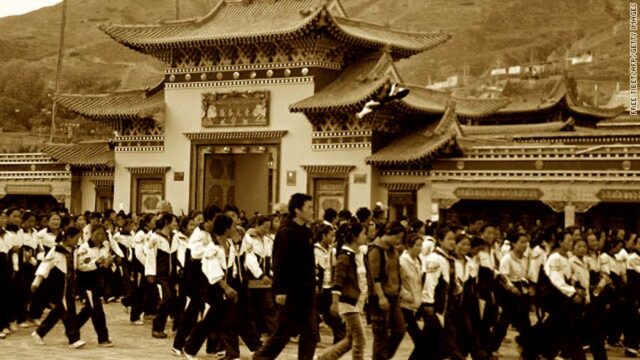His Holiness the Dalai Lama Presides Over Prayers for Victims of Recent Devastating Earthquake in Tibet

His Holiness the Dalai Lama smiling at the congregation as he departs at the conclusion of the prayer ceremony for victims of the recent earthquake in Tibet at Tashi Lhunpo Monastery in Bylakuppe, Karnataka, India on 9 January 2025. Photo by Tenzin Choejor
By — BT NEWSDESK
Bylakuppe, Karnataka: This morning, an estimated 12,000 people, monks, nuns and laypeople gathered in and around the temple at Tashi Lhunpo Monastery re-established in the Tibetan settlement of Bylakuppé, Karnataka, to pray for victims of the recent devastating earthquake in Tibet. The regions of Tibet struck most severely by the earthquake were Shigatsé and Dingri. The principal monastery in Shigatsé is Tashi Lhunpo, which, founded by the First Dalai Lama, Gyalwa Gendun Drup, was the seat of the Panchen Rinpochés.
As it happens, His Holiness the Dalai Lama is presently staying at the Tashi Lhunpo Monastery re-established in South India. His joining a large assembly to pray for the people of Shigatsé and Dingri is therefore especially propitious.
Members of the public from surrounding Tibetan settlements began to arrive very early this morning, and were admitted from 6:15am. Monks sat in orderly rows in the temple. While waiting for the formal prayers to begin, the congregation chanted the mantra of Buddha Shakyamuni.
When His Holiness arrived he took his seat facing colossal gilded images of the Buddha and the First Dalai Lama, as well as prominent photographs of the previous Panchen Rinpoché and his successor, Gendun Chökyi Nyima. To His Holiness’s right sat Sharpa Chöjé Rinpoché, Abbots and former Abbots. They were joined by retired members of the Central Tibetan Administration and the Tibetan Parliament-in-Exile.
Members of the media were allowed into the temple to observe and record His Holiness’s participation in the assembly.
Prayers began with the ‘Three Continuums’, a praise and supplication to the Buddha, followed by the verse for taking refuge and generating the awakening mind of Bodhichitta. Periodically His Holiness turned to survey the gathering of monks and catch their eye.
Prayers continued with the ‘Prayer of the Four Immeasurable Wishes’ and the ‘Samantabhadra Prayer—the King of Prayers’. Tibetan butter tea and bread were distributedand offering prayers were said to bless them.
The Tashi Lhunpo Disciplinarian announced the recitation of prayers led by His Holiness and other spiritual masters. He then read out a list of donations that had been made to support the gathering.
Following a verse of salutation from Nagarjuna’s ‘Fundamental Wisdom’,
‘In dependent arising
there is no ceasing, no arising,
no annihilation, no permanence,
no coming, no going,
no separateness and no sameness,
I prostrate to the consummate Buddha,
the supreme among all teachers,
the one who taught [this] peace,
which is free of elaborations,’
came a recitation of Jé Tsongkhapa’s ‘Praise to the Buddha for Teaching Dependent Arising’.
After chanting the 7th Dalai Lama, Gyalwa Kalsang Gyatso’s ‘Praise to Avalokiteshvara’, the entire assembly recited Avalokiteshvara’s mantra—Om mani padmé hung—for everyone affected by the earthquake. The session concluded with the ‘Prayer of True Words Invoking the Three Jewels’. The assembly and prayers were held in the Buddhist spirit of seeking to transform adverse circumstances into an opportunity for growth and thus a stage on the path to enlightenment.

Members of the Tibetan community watching the proceedings of the prayers for victims of the recent earthquake in Tibet led by His Holiness the Dalai Lama on a big screen in the debate ground of Tashi Lhunpo Monastery in Bylakuppe, Karnataka, India on 9 January 2025. Photo by Ven Zamling Norbu

His Holiness the Dalai Lama in front of the Buddha Statue in the Main Assembly Hall of Tashi Lhunpo Monastery during prayers for victims of the recent earthquake in Tibet in Bylakuppe, Karnataka, India on 9 January 2025. Photo by Ven Zamling Norbu

A senior monk reading our a list of supporters and details of the program at the start of the prayer ceremony for victims of the recent earthquake in Tibet led by His Holiness the Dalia Lama at Tashi Lhunpo Monastery in Bylakuppe, Karnataka, India on 9 January 2025. Photo by Tenzin Choejor

A view inside the Main Assembly Hall during the prayer ceremony for victims of the recent earthquake in Tibet led by His Holiness the Dalia Lama at Tashi Lhunpo Monastery in Bylakuppe, Karnataka, India on 9 January 2025. Photo by Tenzin Choejor

A view inside the Main Assembly Hall during the the prayer ceremony for victims of the recent earthquake in Tibet led by His Holiness the Dalia Lama at Tashi Lhunpo Monastery in Bylakuppe, Karnataka, India on 9 January 2025. Photo by Tenzin Choejor






































